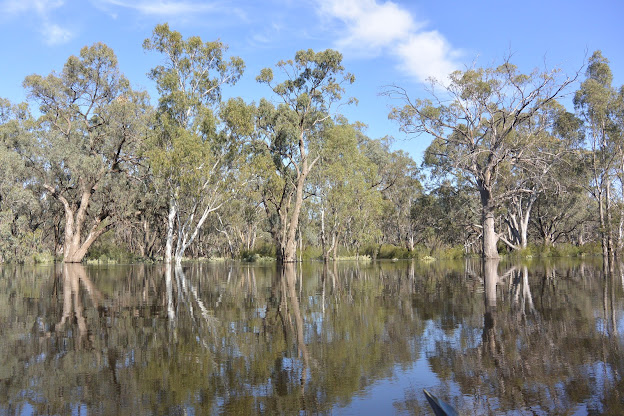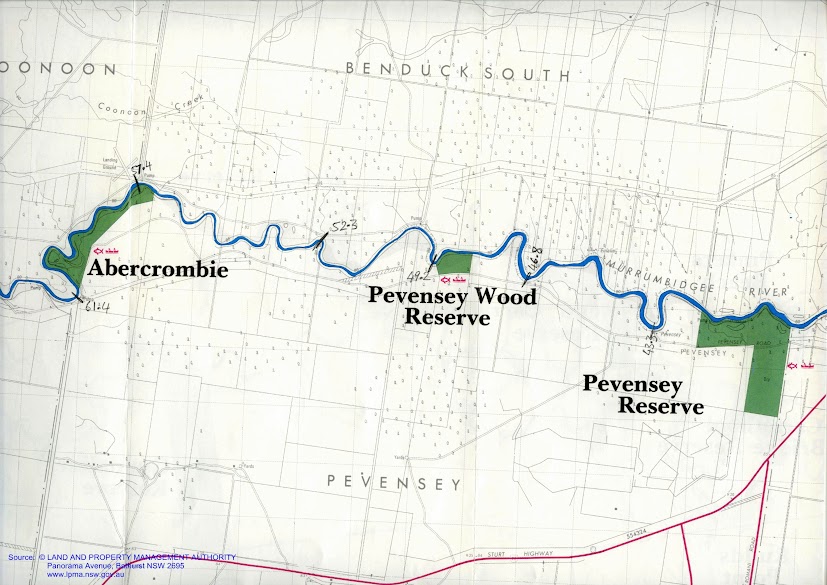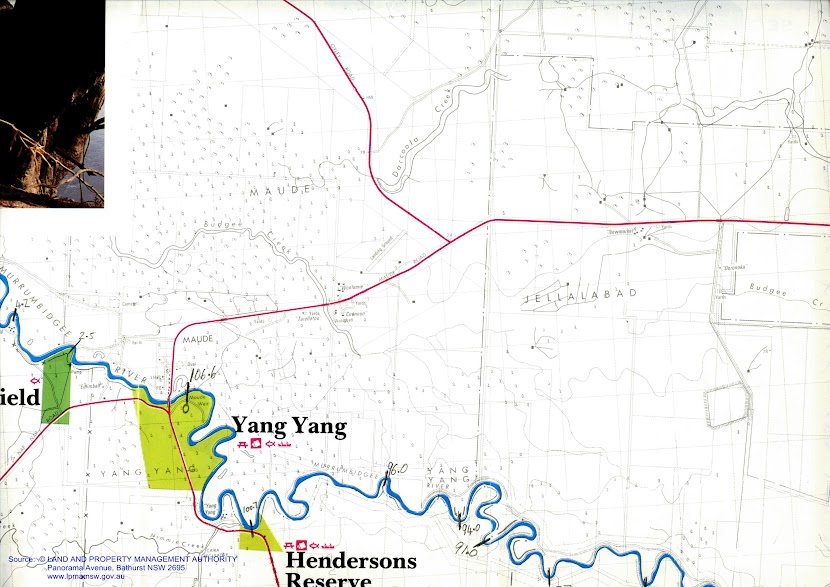Yungera to Tol Tol
 |
| Sunrise, Yungera Station, Boundary Bend, Victoria |
 |
| Yungera Station |
 |
| Yungera Station: pulling my fully laden boat to the river. |
Yesterday I passed a major milestone. Just before Tala Rocks, the only known stone fish trap on the Murray that remains today, I passed the point where I had paddled 1000 km since beginning at the Hume Dam about four weeks ago. If you take away days set aside for organisation, rest and time with family, that's close to an average of 50 km a day, which is the target I set myself given the necessary delay to the beginning of the trip caused by major flooding in the Upper Murray.
YouTube: Approaching the 1200 km mark just after Yungera Station (morning bird call).
 |
Overbank flow through blackbox and river reg gum woodland, just after Yungera Station. Saltbush and Exocarpus understory. |
YouTube: Between 1194 and 1192 opposite the Yungera Island just passed a big area flooded Black Box where where the river and travels more through the forest then it does down its channel... leading to pretty much next to no current in the bends... picking up slightly now ...maybe doing one kilometre an hour ...that area of box Forest is really quite special with trees over 1 m in diameter and and many canoe trees amongst them ...in one spot I counted about five canoe trees in about 200 m.
YouTube: Yungera State Forest beautiful old gums... I've just passed some High ground back here... The High ground tends to be on the outside of the bends it's not surprisingly really has the river is always forming new lower ground on the inside of the bends... meaning that the High ground, the oldest ground built-up through sediment deposition... floodplain sediments or aeolian Sandhill sediments and this is usually where you will find your Black Box ...not surprisingly ...so outside of the bends and usually at the start of the bends you'll find this fellow, Acacia stenophylla with its long thin dark green leaves... and the peak usually not the end and your find Black Box on the outside of the bends and Red Gum floodplain forest on the inside of the bends and immediately downstream on the benches.
 |
| Old Black Box with Saltbush and Lignum understory on the outside of a bend. |
 |
Organic matter stranded in an eddy amongst vegetation (Saltbush, Lignum and River Myall) at the bank top NSW, forming a thick mat on the surface for the first metre away from shore. |
 |
Right at the peak of the flood wave... Rising flood waters spreading through a Black Box woodland at Boundary Rocks, opposite Cod's Head Reef Campsite, Yungera Island. |
At Boundary Rocks I pulled up for a short break. There, the most enormous whirlpools visibly sucked down the surface of the river by up to 10 cm and have a diameter of up to 5 m. Some of them appear suddenly. I took care to stay well away. They are caused by the way the current flows over the rocks below them. We tend to think in two dimensions when it comes to water, but movement occurs in three. The swirls caused by snags and rocks include currents that come to the surface, creating boils and others that go down. When these are extreme they cause whirlpools. Its part of what makes some parts of rivers quite dangerous. The Murray seems so tame, but it has its traps. It is, after all, a wild river. On the shore I can see the waters edge gradually creeping millimetre by millimetre further, or is it receding, when you're at the peak it's hard to tell.
 |
| Dragonfly resting on my camera. |
Over lunch I called into Meilman Station. Meilman was settled around 1850 and has been run by the Gorman family since the 1920’s. After serving me a hearty lamb roast sandwich, Andy brought out some of his research into local history, including old newspaper articles and photos. One of the photos showed the paddle steamer Ruby moored in front of their house in high water in 1931. The sandhill on which their house is built is at close to 3 metres higher than the current high river. High rivers were frequent before the Hume Dam was built in the 1960's. The changing levels shaped the banks until there was a stable angle, bit by bit, year by year. Now with high rivers happening less frequently, the shaping is happening all at once, which is one of the reasons for the bank collapse we are seeing along many stretches of the Murray. Andy's son, Alfred, showed me some great drone footage he had shot of the high river. They had been using the drone to look for some missing sheep. The property stretches all the way to Euston township and includes several lakes and old water course, many of which run once the river is up. This is what makes looking for sheep in these times more difficult, but is also what makes the understanding of landholders like the Gormans such a valuable resource. Over time I would like to get in contact with as many river landholders as possible and ask them how they see the river has changed, what they think the issues are and what the causes might be.
 |
| Meilman Station ahead. |
 |
| Reminiscences of a pioneer - Edmund Morey - A bush Christening. Morey wrote a number of articles. These are searchable on Trove and held in the National Library, Canberra ( Edmund Morey - squatter, Euston N.S.W., 1846). Also part of the Balranald Euston Tooleybuc History Project, Country Areas Program, North West Riverina, Schools Commission, 1984 - Frontier and pioneer life - 18 pages. Here is a record of the 14 entries Edmund Morey wrote about life as a pioneer on the Murray River. |
 |
Paddlesteamer Marion loading wood at Mielman Station in the 1931 flood. Gorman family. |
After Meilman I made for a sandhill the Gormans had told me about, just after invincible bend. In this area the river seems to be doing its old trick of meandering around inside the ancient meanders. This leads to a lot of hairpin bends. During high rivers like this, the river flows straight through the forest rather than around the bends, so instead of great current, I had a lot of areas of dead water. In one of these places I came across what I thought at first was a very odd looking snake. It turned out to be a blue tongue lizard attempting to cross the river. It had blown up its abdomen with air, making it look a bit like a balloon animal. To make headway it wiggled from side to side and tried to do things with its feet as well. Nothing was happening quickly, but it made it across. Lucky there were no whistling kites in the area.
 |
| Some movement in the water once again... |
YouTube: This cutting this is so large that it is as wide as the main river channel I will take the original channel though because I am interested in the comparison between the current state and how the river looked in the 1800's so this is the channel I'll be taking. The river channel I'll be following the original channel is still wider but you can see in high water conditions like this that most of the river is flowing through the cutting.
The still air today was great for both photography and recording bird call. There were perfect reflections and the sounds seemed to be magnified by the forest. The most beautiful call was from a butcher bird, whose whistling call defies its rather nasty habit of impaling its prey on spikes. The cockatoos were in pairs and small groups, nesting communities. They cause quite a problem for local fruit growers and the almond plantations in the area which they see as a gifted food source. Locals say that the flocks in summer have to be seen to be believed.
 |
There looks like there has been a fire through here with charring on the base of some of the trees and epicormic growth up much of the trunks. |
 |
First sign of the Avery's boat... the first boat I have seen on the water since around Gunbower...
YouTube: Coming into Invincible Bend just passed 1158 floodplain River Red Gum forest I've just met Barry and daughter, Jess in that boat and they have invited me to stay in their place have a night how nice is that! This is Invincible Bend. Barry Avery at Little River Cottage, Invincible Bend. |
Tomorrow I make for Robinvale, where I will stock up on supplies.
















































